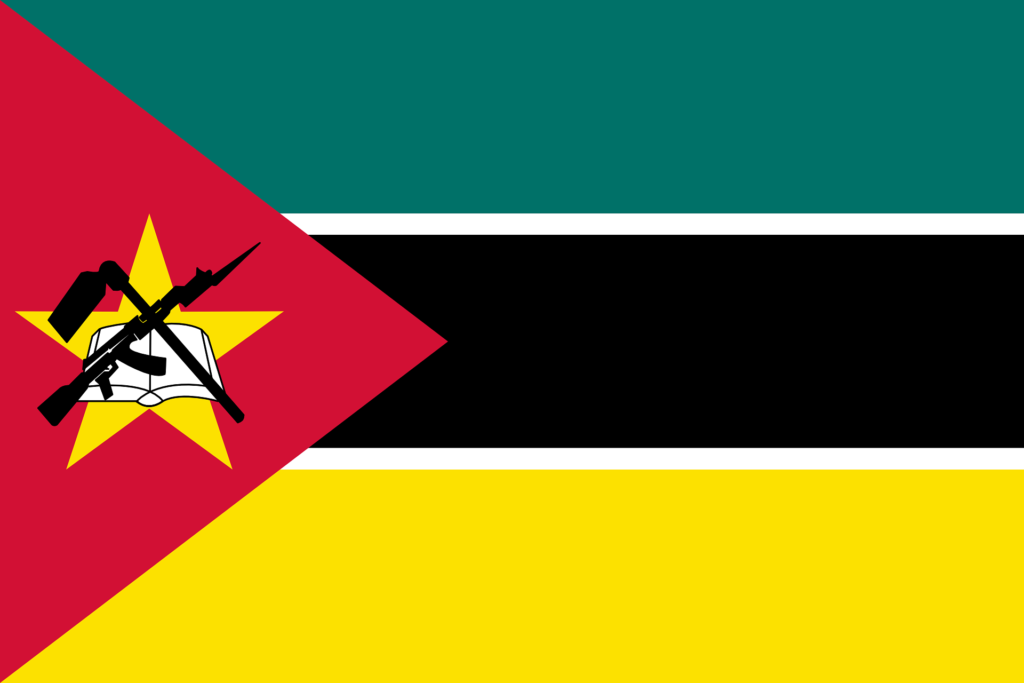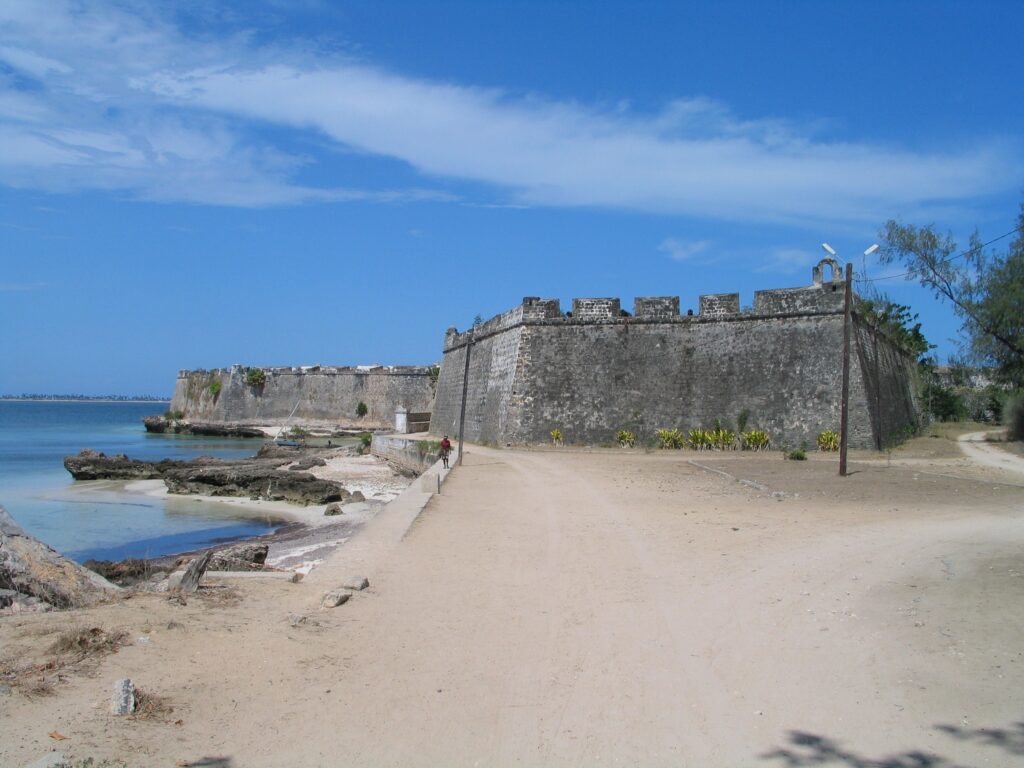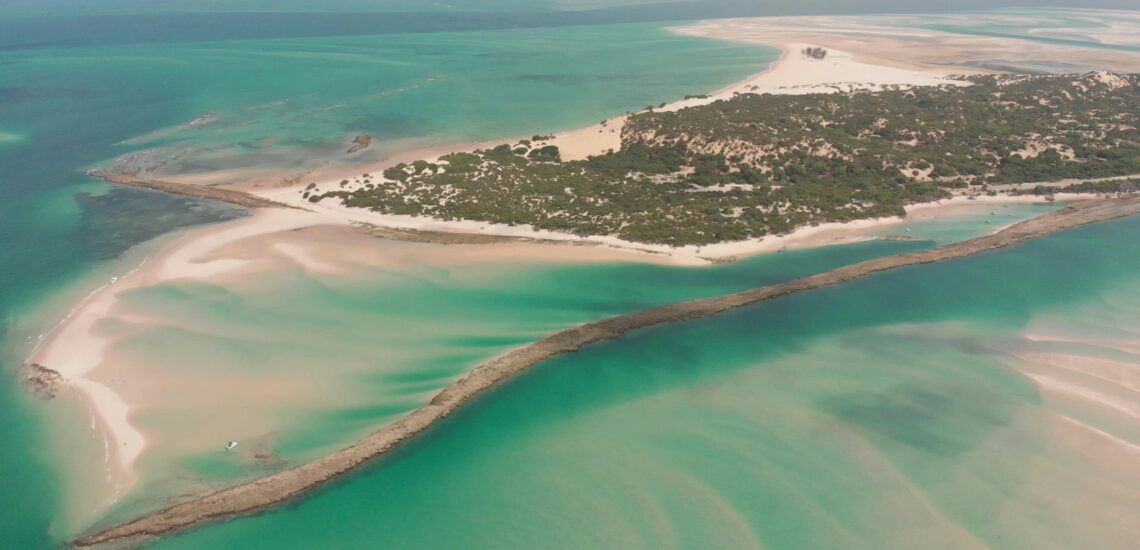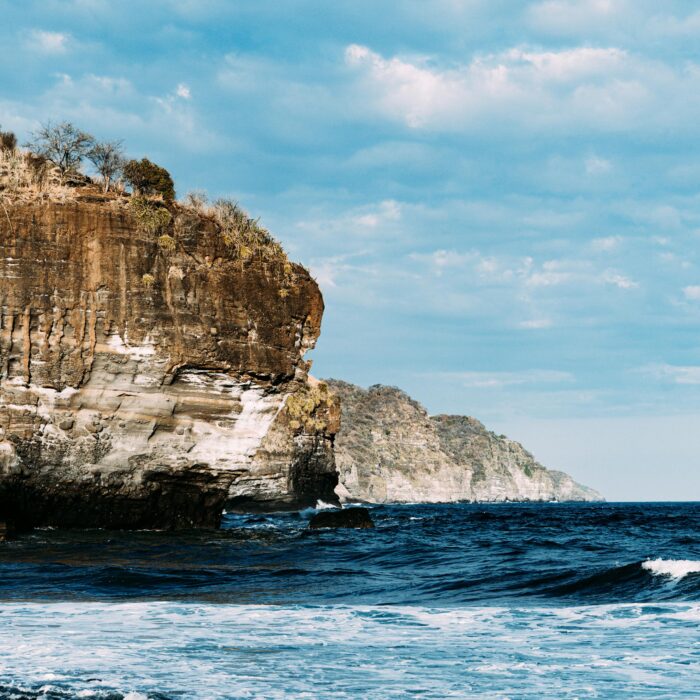Quick facts about Mozambique:
- Population: Approximately 33 million people.
- Capital: Maputo.
- Official Language: Portuguese.
- Other Languages: Mozambique has a rich linguistic diversity with several indigenous languages such as Emakhuwa, Xichangana, and Elomwe.
- Currency: Mozambican Metical (MZN).
- Government: Unitary presidential republic.
- Major Religion: Christianity (predominantly Roman Catholic and Protestant), with a significant Muslim minority.
- Geography: Located in southeastern Africa, bordered by Tanzania to the north, Malawi and Zambia to the northwest, Zimbabwe to the west, and South Africa to the southwest. It has a long coastline along the Indian Ocean to the east.
Fact 1: Mozambique is the only country whose flag contains an image of an AK-47
The flag of Mozambique, adopted in 1983, includes a distinctive emblem featuring an AK-47 rifle crossed with a hoe, and a book.
The AK-47 symbolizes the country’s struggle for independence and the ongoing commitment to defending the nation. The hoe represents agriculture and the importance of farming in Mozambique’s economy. The book signifies education and the country’s aspiration for progress and development.

Fact 2: Mozambique has a very young population
Mozambique has a notably young population. A significant portion of the population is under the age of 15, making it one of the youngest populations in the world.
Demographics: As of recent estimates, approximately 44% of Mozambique’s population is under 15 years old. The country’s median age is around 17 years, which is much younger compared to global averages.
Implications: This youthful demographic poses both opportunities and challenges. On one hand, a young population can drive economic growth and innovation, potentially contributing to a dynamic labor force in the future. On the other hand, it also presents challenges such as the need for adequate education, healthcare, and employment opportunities to harness the potential of this large youthful segment effectively.
Development Efforts: Addressing the needs of a young population requires significant investment in education, healthcare, and infrastructure. Mozambique is working to improve these areas to ensure that the benefits of its youthful demographic can be fully realized.
Fact 3: There are many islands in Mozambique
Mozambique is home to a significant number of islands, which contribute to the country’s rich geographic and cultural diversity. The coastline of Mozambique stretches over 2,400 kilometers, providing ample opportunities for numerous islands and archipelagos.
Notable Islands and Archipelagos:
- The Bazaruto Archipelago: Located off the coast of Vilankulos, this archipelago consists of several islands, including Bazaruto, Benguerra, Magaruque, and Santa Carolina. It is known for its stunning beaches, clear waters, and rich marine life, making it a popular destination for tourists and divers.
- The Quirimbas Archipelago: Situated in the northern part of Mozambique, this archipelago includes about 32 islands. The Quirimbas are renowned for their natural beauty, coral reefs, and traditional Swahili culture.
- Inhaca Island: Located near Maputo, the capital city of Mozambique, Inhaca Island is known for its beautiful beaches, marine reserves, and research facilities.
Geographic Significance: These islands and archipelagos enhance Mozambique’s appeal as a destination for eco-tourism, diving, and beach vacations. They also play an important role in the country’s marine biodiversity and conservation efforts.

Fact 4: In the pre-colonial period, the place had its own kingdoms
Before the colonial period, the region that is now Mozambique was home to several influential and well-established kingdoms and empires.
The Kingdom of Gaza: One of the most prominent pre-colonial states in Mozambique was the Kingdom of Gaza. Established in the early 19th century by the Nguni-speaking Shona people, it was a powerful kingdom that controlled a large part of southern Mozambique. The kingdom was known for its military prowess and extensive trade networks.
The Kingdom of Mutapa: To the northwest of Mozambique, in the area now part of Zimbabwe, was the Kingdom of Mutapa. This kingdom had significant influence over the regions of northern Mozambique. It was known for its wealth from gold mining and trade with the Swahili coast.
The Maravi Empire: In the central and northern regions of Mozambique, the Maravi Empire was another influential state. It was known for its trade networks and interactions with neighboring regions.
Swahili City-States: Along the coast of Mozambique, several Swahili city-states thrived. These city-states, including Kilwa, Sofala, and others, were important centers of trade and culture, engaging in commerce across the Indian Ocean.
Fact 5: Mozambique is a popular vacation destination for tourists from South Africa
Mozambique is a popular vacation destination for tourists from South Africa, largely due to its beautiful beaches, vibrant marine life, and cultural attractions. The country’s appeal is enhanced by its proximity to South Africa, making it an attractive option for a relatively short trip.
New Infrastructure Developments: Recent improvements in infrastructure, such as the development of new roads, have made traveling to Mozambique more accessible and convenient. For example, the upgrade of the road network connecting South Africa to Mozambique has significantly improved the ease of travel for tourists. This new infrastructure facilitates smoother and more efficient journeys, contributing to increased tourism from neighboring countries.
Driving in Mozambique: While the new roads have improved access, driving in Mozambique can still be a unique experience. Travelers might encounter various conditions, from well-maintained highways to more challenging rural roads. In some areas, roads may be less developed, and travelers should be prepared for varying road conditions. Additionally, local driving practices and road signage might differ from those in South Africa, which could affect the driving experience.
Note: When planning a solo trip around the country, check if you need an International Driving Permit in Mozambique to rent and drive a car.

Fact 6: In Mozambique, linguistic, religious and national diversity
Mozambique is characterized by significant linguistic, religious, and national diversity, reflecting its rich cultural heritage and complex history.
Linguistic Diversity: Mozambique is home to a multitude of languages. Portuguese, the official language, is used in government, education, and media. However, there are also over 40 indigenous languages spoken across the country. Major Bantu languages include Chichewa, Shangaan (Tsonga), and Makhuwa. This linguistic diversity reflects the varied ethnic groups and historical influences present in Mozambique.
Religious Diversity: Mozambique has a diverse religious landscape. The majority of the population identifies as Christian, with Roman Catholicism and various Protestant denominations being prominent. There is also a significant Muslim population, particularly along the coast and in urban areas. Indigenous religious practices and beliefs are also present and often coexist with Christianity and Islam, reflecting the country’s historical and cultural blend.
National Diversity: The national diversity in Mozambique is evident in its ethnic composition. Major ethnic groups include the Makhuwa, Tsonga, Chewa, Sena, and Shona, among others. Each group has its own distinct cultural practices, traditions, and social structures. This ethnic diversity contributes to the vibrant cultural tapestry of Mozambique, influencing everything from cuisine and music to festivals and art.
Fact 7: Mozambique has been known for trading cities for centuries
Mozambique has a long history of trading cities that have been important centers of commerce and cultural exchange for centuries. The coastal region of Mozambique, in particular, has been a significant hub for trade due to its strategic position along the Indian Ocean trade routes.
Historical Trading Cities:
- Sofala: One of the most notable historical trading cities in Mozambique, Sofala was a major center of trade in the 11th and 12th centuries. It was part of the Swahili coast’s extensive trading network, engaging in commerce with traders from the Middle East, India, and China. Sofala was known for its involvement in the gold trade and was an important port for the trans-oceanic trade routes.
- Kilwa Kisiwani: Although located in what is now Tanzania, Kilwa Kisiwani was closely connected with Mozambique through trade. It was a powerful city-state that controlled trade routes along the East African coast and had significant economic and cultural interactions with Mozambique’s coastal cities.
- Inhambane: This historic port city was another key player in Mozambique’s trade history. Inhambane has been a trading hub since the 16th century, engaging in commerce with European, Arab, and Asian traders. It was known for its trade in spices, ivory, and gold.
Impact of Trade: These cities played a crucial role in the economic and cultural exchanges between Africa, the Middle East, and Asia. They facilitated the flow of goods, ideas, and cultural practices, contributing to the development of Mozambique’s coastal regions and shaping its historical and economic trajectory.

Fact 8: Poaching is common in Mozambique
Poaching has been a severe issue in Mozambique, with significant impacts on its wildlife populations. The last rhinoceros in Mozambique was killed in 2013, a tragic milestone that underscored the gravity of the poaching crisis. Rhino poaching, driven by the high value of rhino horn in illegal markets, severely depleted the country’s rhino population. The loss of these iconic animals highlighted the urgent need for more effective conservation measures.
In response, Mozambique has ramped up anti-poaching efforts, collaborating with international organizations and improving law enforcement to protect its remaining wildlife. These initiatives include strengthening protected areas and involving local communities in conservation. Despite these efforts, the challenge of poaching persists, requiring sustained attention and resources to prevent further losses and support the recovery of Mozambique’s endangered species.
Fact 9: Gorongosa National Park is considered the best in the South African region
Gorongosa National Park is widely regarded as one of the finest national parks in Southern Africa, celebrated for its extraordinary biodiversity and successful conservation efforts. Located in central Mozambique, the park covers over 4,000 square kilometers and features a range of ecosystems, from savannas to wetlands, which support a rich variety of wildlife.
The park’s reputation is bolstered by its remarkable recovery and restoration. Following severe damage during Mozambique’s civil war, extensive rehabilitation efforts have revitalized its ecosystems and wildlife populations. The collaboration with conservation organizations, particularly the Gorongosa Restoration Project, has been instrumental in this process.
Mozambique is profoundly affected by climate change, experiencing a range of environmental and socio-economic challenges. The country’s extensive coastline and reliance on agriculture make it particularly vulnerable. Increased frequency and severity of extreme weather events, such as cyclones, floods, and droughts, have led to significant damage to infrastructure, agriculture, and natural ecosystems.

Fact 10: Mozambique is strongly affected by climate change
Coastal areas are particularly at risk from rising sea levels and coastal erosion, which contribute to flooding and displacement. Agriculture, a crucial sector for Mozambique’s economy and the livelihoods of many people, is disrupted by changing rainfall patterns and prolonged droughts, which impact crop yields and food security.

Published September 15, 2024 • 9m to read





